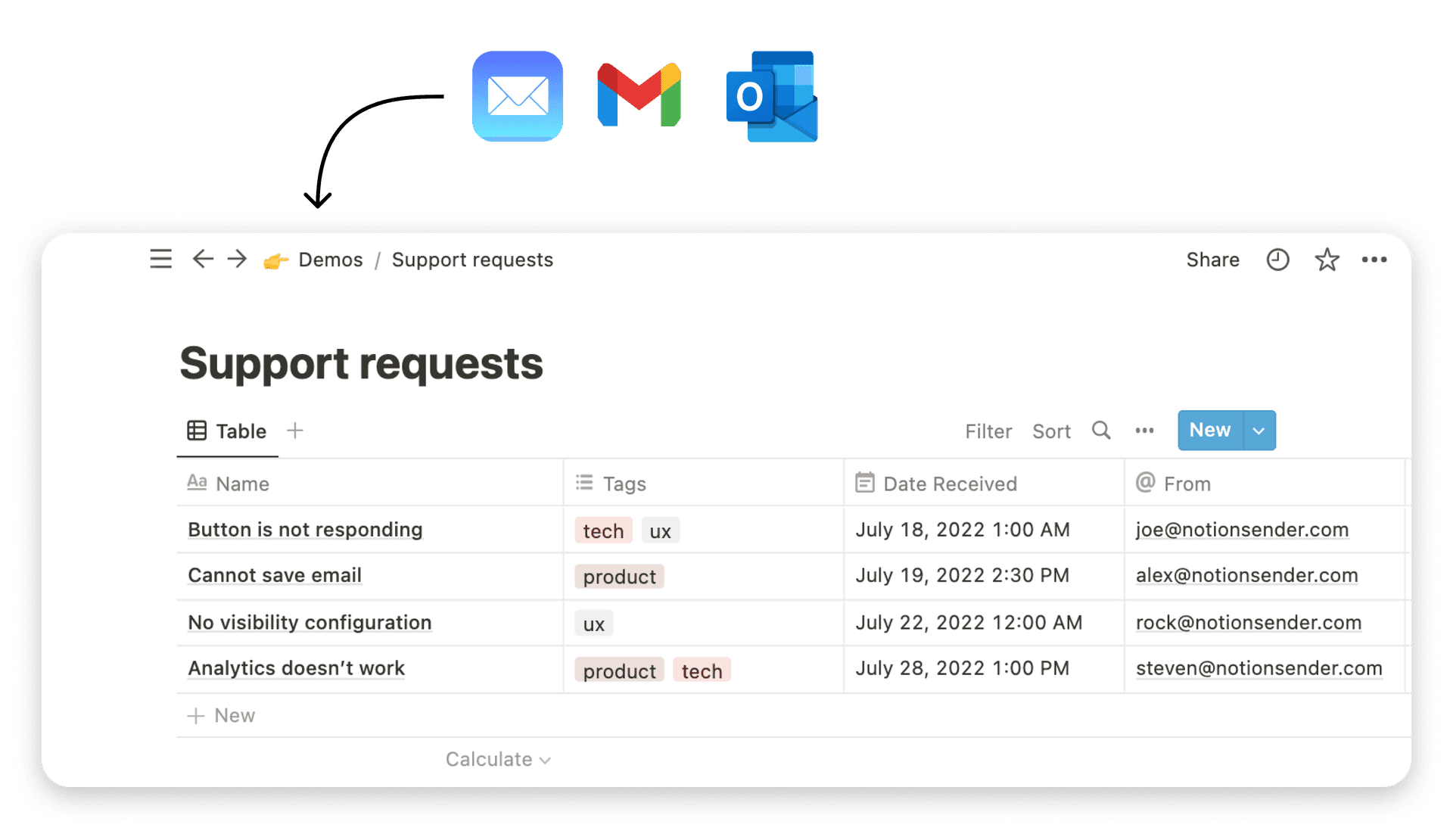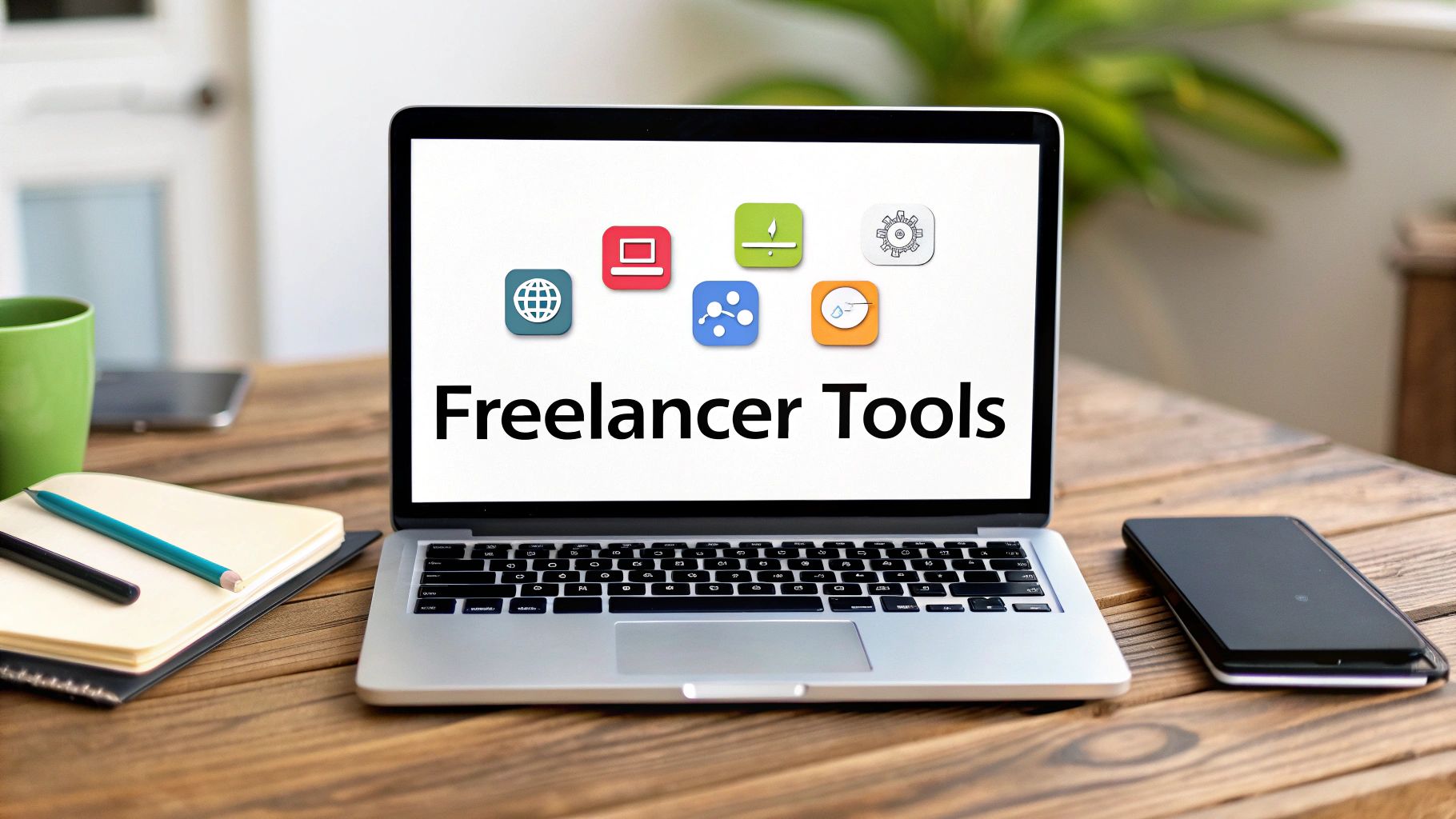How to Write About Yourself Without Cringing
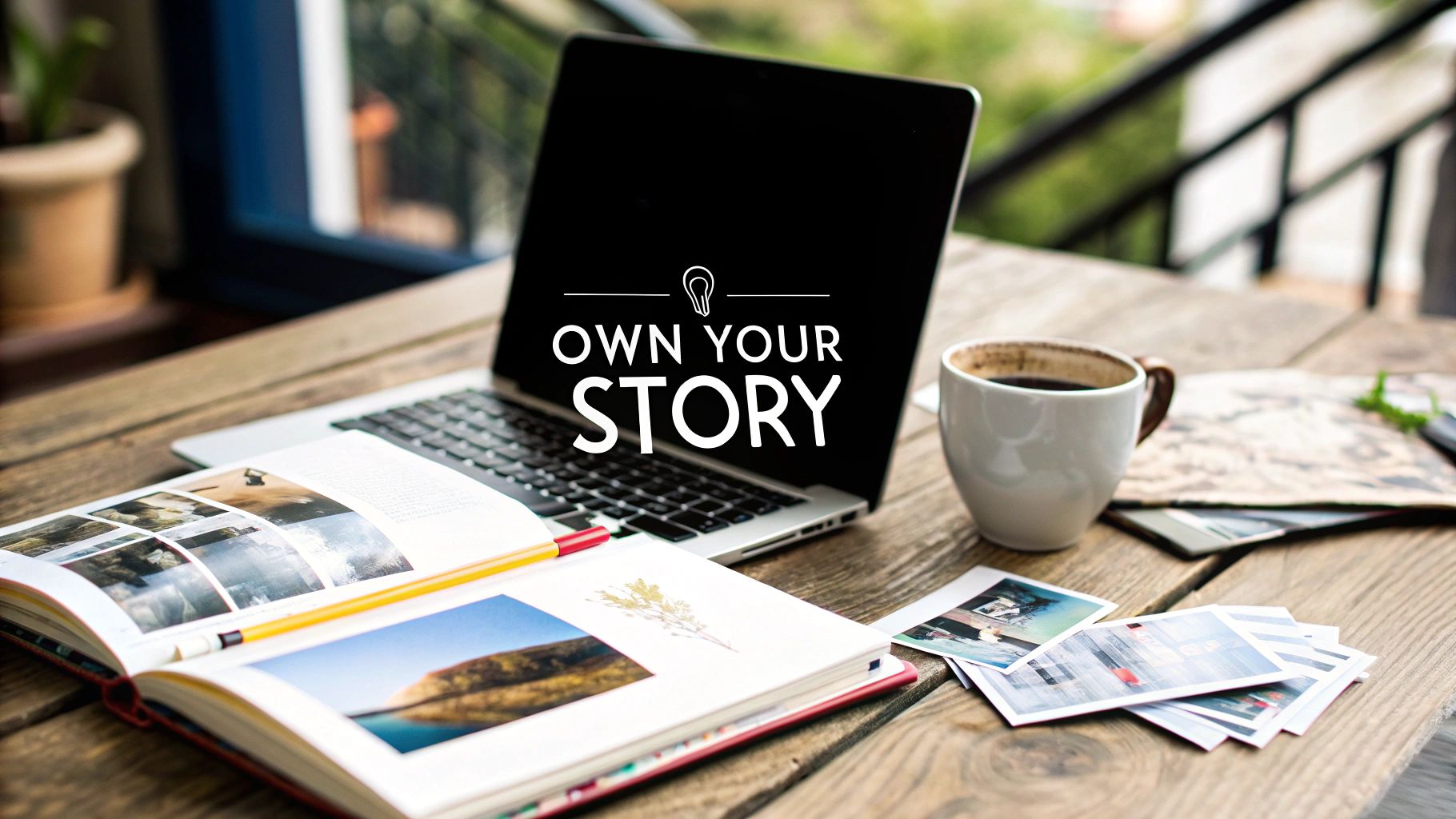
Writing about yourself is always a bit awkward, isn't it? But here’s a little secret I've learned over the years: the key is preparation, not perfection. Before you even try to write a single sentence, you need to do some groundwork. It all comes down to figuring out who you're talking to, what you want to say, and what proof you have to back it up. This prep work turns that scary blank page into a simple roadmap.
Build Your Foundation Before You Write

The toughest part of writing about yourself is just getting started. That blinking cursor on a blank screen can feel pretty intimidating. The trick is to lay a solid foundation before you start writing. A little strategic prep makes the whole process feel less like a chore and a lot more manageable.
Think about it like building a house. You wouldn't just start nailing boards together at random; you’d get a blueprint first. Your writing "blueprint" starts with one simple but crucial question.
Pinpoint Your Audience and Goal
So, who are you actually writing this for? The answer to that question changes everything. A quick bio for a casual networking event has a completely different vibe than a personal statement for a med school application.
Before you go any further, get crystal clear on these two things:
- Your Reader: Is it a recruiter skimming dozens of LinkedIn profiles? A potential client trying to see if you're the real deal? Or maybe a college admissions officer looking for someone who stands out?
- Your Goal: What do you want this person to do after reading your bio? Do you want them to hire you, send a connection request, or accept your application?
For instance, a freelancer trying to land a new client would focus on their problem-solving chops and highlight successful projects. An artist applying for a grant, on the other hand, would want to talk more about their creative vision and past exhibitions. Every single word you choose should be aimed at that specific audience and goal.
Your personal bio isn't a one-size-fits-all document. It’s a targeted piece of communication designed to connect with a specific person and get a specific result.
Gather Your Raw Materials
Once you know who you're talking to, it's time to pull together the "raw materials" for your story. Don't even think about crafting perfect sentences yet. This stage is all about brainstorming and collecting your bits and pieces. You're just taking inventory.
Open up a document and just brain-dump everything you can think of related to:
- Key Achievements: What are you genuinely proud of, professionally or personally?
- Core Skills: What are you really, truly good at? Think both hard skills (like data analysis) and the softer stuff (like being a great communicator).
- Defining Experiences: What are the moments or projects that have really shaped who you are today?
- Personal Values: What principles guide how you work and make decisions?
This list becomes your well of information. When you finally sit down to write, you won't be staring into space, grasping for ideas. You'll just be picking and choosing the most relevant details from the list you already made. If you need a good system for this, check out these ways to use Notion to send emails and manage content. Doing this initial legwork is the best way to beat writer's block and make sure your final bio is focused and powerful.
Crafting Your Authentic Personal Brand Story
Your experiences aren't just a random collection of jobs and projects; they're the raw materials for your unique story. When you figure out how to write about yourself, you’re not just listing facts—you’re weaving a narrative that connects with people on a human level. This is the heart of your personal brand story.
Turning your accomplishments into a story that sticks starts with finding its central theme. Are you the resilient pro who shines under pressure? The creative problem-solver who spots solutions others miss? Or the innovator who’s always pushing what’s possible? Pinpointing this core theme gives your narrative a laser focus.
Uncover Your Core Narrative Theme
Think of your career like a movie. What’s the genre? What’s the main character (that's you) really known for? This isn't about inventing some fake persona. It's about recognizing the consistent thread that runs through your entire professional life.
Look back at your biggest wins. What’s the common denominator? Maybe you have a knack for turning struggling projects into major successes (resilience). Or perhaps you’ve consistently developed unconventional strategies that delivered big results (creative problem-solving).
This central theme becomes the anchor for your story. It ensures every anecdote and detail you share serves a clear purpose, making your personal brand feel both authentic and unforgettable.
This infographic breaks down a few common themes to help you find your own.
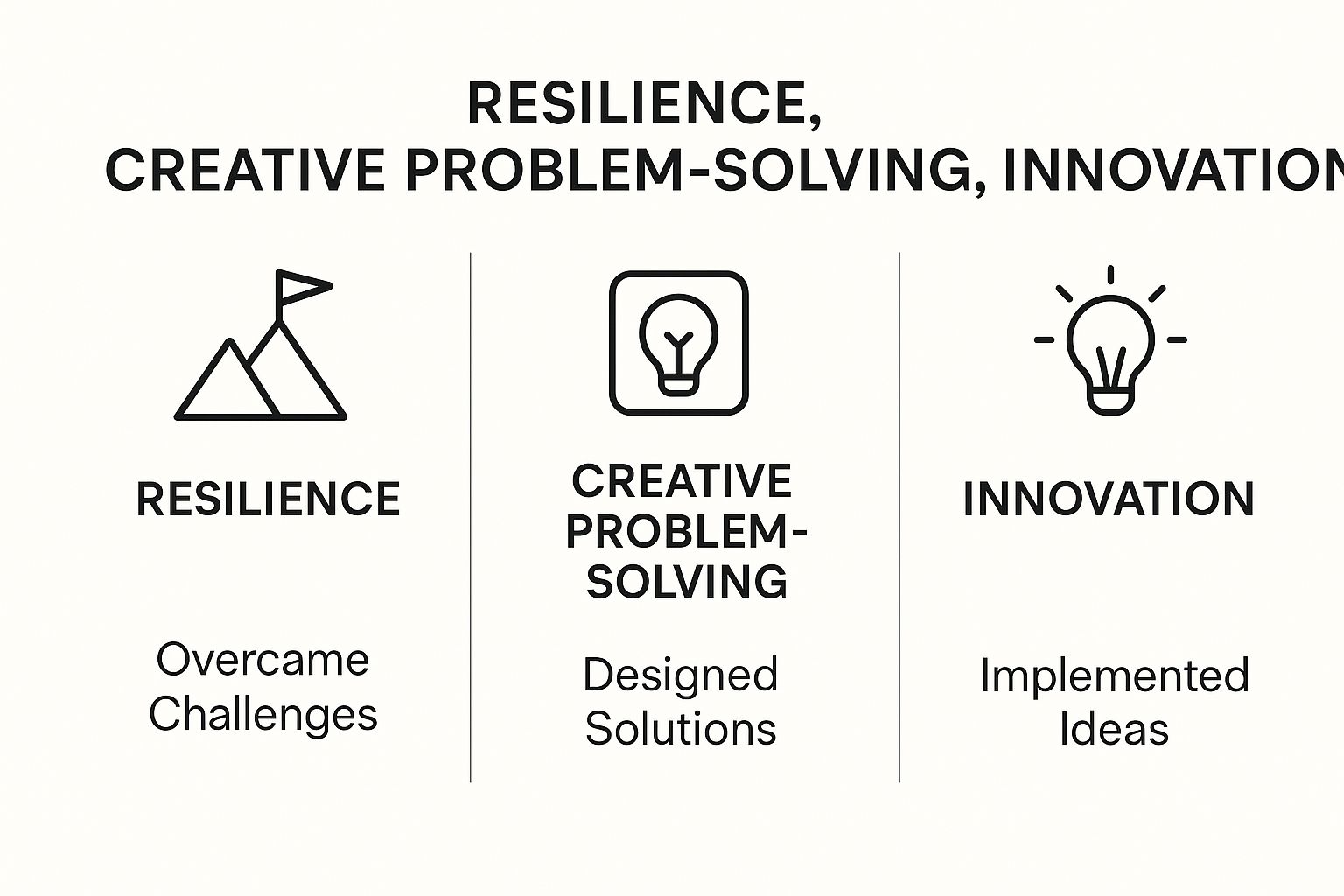
Seeing these themes laid out can help you frame your own experiences and build a powerful narrative around your professional identity.
Select Anecdotes That Bring Your Story to Life
Once you have your theme, it's time to dig up specific stories that show it in action. A generic claim like, "I'm a great leader," is easy to ignore. But a quick story about how you guided a team through a chaotic product launch? That’s compelling and actually proves your point.
Your story shouldn’t just tell people who you are—it should show them. Choose moments that highlight your skills and character through real-world examples.
Start building a "story bank" by listing key moments from your career that fit your theme. For each one, quickly jot down:
- The Situation: What was the context?
- The Challenge: What was the specific problem you were up against?
- The Action: What exactly did you do to solve it?
- The Result: What was the positive outcome?
This simple exercise gives you a goldmine of powerful, ready-to-use content for your bio, resume, or social media profiles. With over 4.33 billion people on social media, your online story has never been more critical. People spend an average of 2 hours and 22 minutes on these platforms every day, so a strong, authentic narrative is your best bet for cutting through the noise. If you want to dive deeper, you can explore more copywriting statistics to see just how important strategic presentation is.
Weave Your Narrative Together
Now you can pull these pieces together into a single, flowing story. Kick things off by introducing your core theme, then back it up with one or two of your strongest anecdotes. The goal is to create a narrative that’s not just impressive but also relatable.
By focusing on your authentic brand story, you elevate yourself beyond a simple list of qualifications. You create a genuine connection that makes people remember you and, more importantly, want to work with you. That's the real win when you write about yourself.
Finding the Right Tone of Voice for Any Platform

It’s one thing to know what you want to say about yourself. It's another thing entirely to know how to say it. The tone you strike can be the difference between connecting with your audience and completely pushing them away. When you're figuring out how to write about yourself, this is where the real magic happens.
Your authentic voice should always be the foundation of your writing. But that doesn't mean it's one-size-fits-all.
Think of it like getting dressed. You have a personal style, but you wouldn't wear a tuxedo to a backyard barbecue. In the same way, the buttoned-up, third-person bio you use on a corporate website just won't land on a personal statement for a creative grant.
Matching Your Voice to the Venue
Every platform has its own unwritten rules. Your LinkedIn profile, for instance, is your digital handshake—it needs to project professional competence. Your personal blog’s "About Me" page? That's your chance to be more conversational and let your personality shine.
The goal isn't to sound like a different person everywhere you go. It's to align your tone with what people expect in that specific space.
This is a tricky balancing act between confidence and humility. You need to own your accomplishments without sounding arrogant, and be professional without coming across as a robot. A great first step is treating yourself like a brand and establishing brand voice guidelines to keep you consistent.
Matching Your Tone to the Platform
So, how do you decide which "mask" to wear? It all comes down to the context—the platform, your audience, and what you want to achieve. A professional tone builds authority, while a conversational one builds rapport.
Here's a quick guide to help you pick the right approach for some common scenarios.
| Tone | Best For | Key Characteristics | Example Snippet |
|---|---|---|---|
| Professional | LinkedIn, corporate bios, resumes, academic applications. | Objective, third-person, highlights achievements and skills. | "John Doe is a marketing strategist with over ten years of experience..." |
| Conversational | Personal blogs, "About Me" pages, social media profiles. | Friendly, first-person, uses approachable language. | "Hey, I'm Jane! I've spent the last decade nerding out about marketing..." |
| Witty/Creative | Creative portfolios, artist statements, networking emails. | Humorous, clever, personality-driven, uses storytelling. | "By day, I wrangle code. By night, I dream up stories about dragons..." |
Ultimately, this table is just a starting point. The best bios often blend elements—a professional profile can have a conversational touch, and a creative bio can still showcase serious skills.
Striking the Right Balance
Finding your tone is really an exercise in self-awareness. It’s about knowing which parts of your personality to dial up or down depending on the room you're in. If you're naturally funny, a bit of wit in your LinkedIn summary can make you incredibly memorable. A full-on stand-up routine, however, might miss the mark.
Your tone isn't about creating a new persona; it's about showcasing the most relevant version of your authentic self for a specific audience.
This is especially true in less formal communications, like email. You can absolutely maintain your professionalism while still sounding like an actual human being. In fact, mastering a warm, genuine tone is one of the key tips for sending emails that make people smile and actually want to connect with you.
When you get the tone right, you build trust. You're showing your audience that you understand the context and you're communicating with them thoughtfully. Practice adjusting your voice across a few different platforms. Soon enough, it will feel like second nature, letting your story shine through no matter where you tell it.
How to Structure Your Narrative for Maximum Impact
<iframe width="100%" style="aspect-ratio: 16 / 9;" src="https://www.youtube.com/embed/jAY5Y9XWu4I" frameborder="0" allow="autoplay; encrypted-media" allowfullscreen></iframe>
A great story isn't just about what you say—it's about how you say it. Without a solid structure, even your most impressive accomplishments can get lost and fail to connect with your reader.
Think of it like building a house. You need a blueprint. A logical flow guides your reader from a compelling opening to a memorable conclusion, making your story stick.
A fantastic tool for this is the classic storytelling arc. It’s a simple, powerful framework you see everywhere, from blockbuster movies to viral personal essays. And it works wonders when you need to write about yourself.
The Classic Storytelling Arc
This isn't just for fiction writers. It’s the perfect way to frame your professional journey or a pivotal life experience, turning a dry list of facts into an engaging narrative that people actually want to read.
Here’s the breakdown:
- The Hook: Kick things off with an opening that grabs immediate attention. This could be a surprising statistic, a bold claim, or an intriguing question that makes them need to know more.
- The Context: Quickly set the scene. Where were you in your journey before the main event you're about to describe? Give just enough background for the story to make sense.
- The Challenge: This is the heart of your story. Introduce the core conflict, problem, or obstacle you faced. What was the moment that truly tested your skills and character?
- The Resolution: Time for the payoff. Explain how you tackled the challenge. Focus on the specific actions you took and the positive outcome, highlighting what you learned or how you grew along the way.
Using this simple arc gives your story a natural momentum. It creates a satisfying journey for the reader, making your experiences far more relatable and impactful. When you’re trying to figure out how to send the perfect email to get a response, this kind of clear, structured storytelling can make all the difference.
Choosing Your Structural Approach
While the storytelling arc is a fantastic all-rounder, it's not the only way to organize your narrative. Depending on your goal, other approaches might highlight your strengths even better.
To really map out your key events and get a bird's-eye view, it helps to create a comprehensive autobiography outline. Don't skip this planning phase; it’s crucial.
Here are a couple of common structures to consider:
- Chronological: This is the most straightforward approach—telling your story from beginning to end. It's perfect for showing a clear, linear path of growth and progression over time.
- Thematic: Instead of following a timeline, you can build your story around key themes like "leadership," "innovation," or "resilience." This is incredibly effective when you want to showcase specific strengths by pulling examples from different points in your life or career.
No matter which structure you choose, the goal is the same: create a logical, engaging flow that spotlights your best qualities and leaves a lasting impression.
Editing and Polishing Your Story Until It Shines
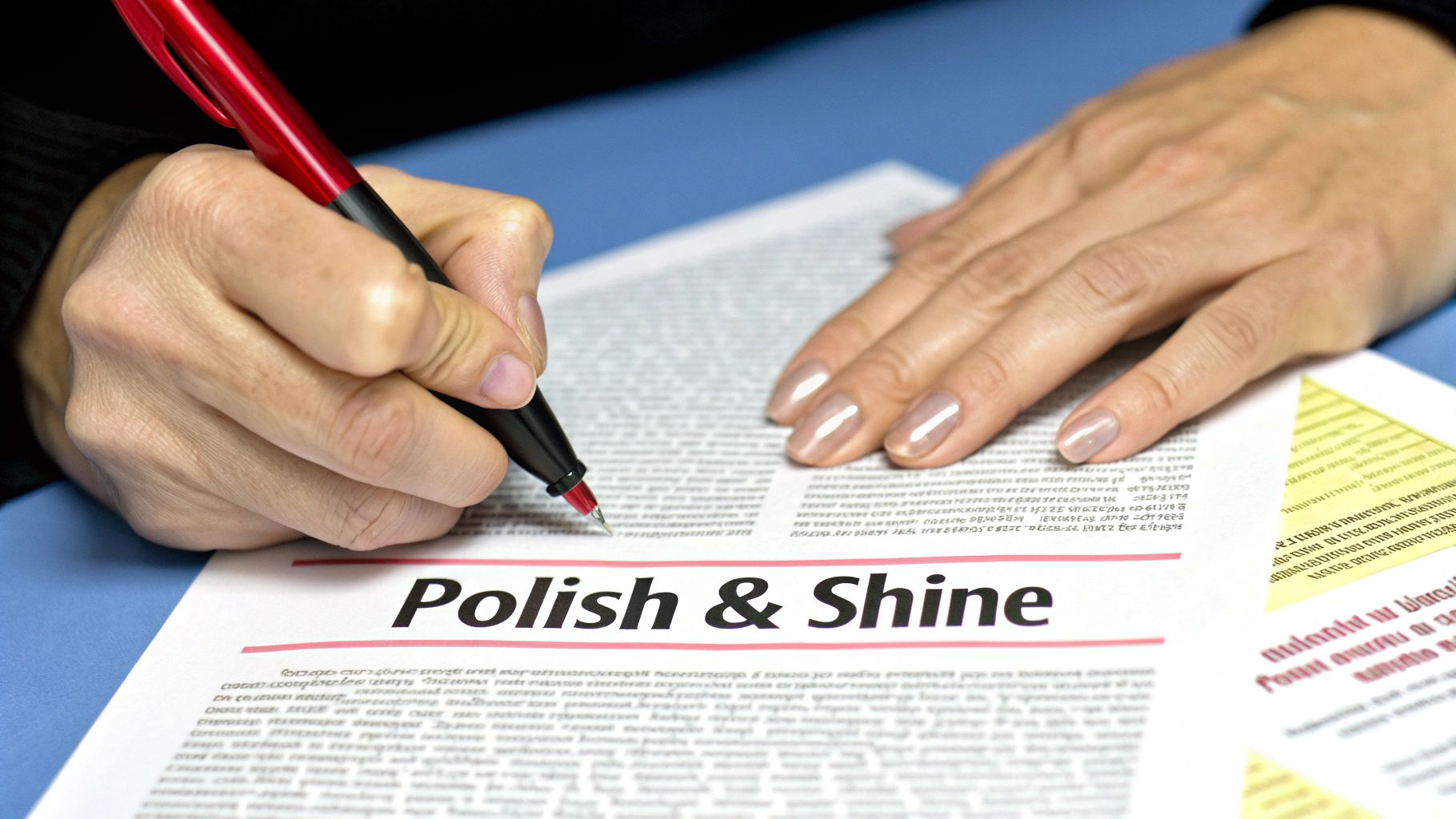 Your first draft is never your final one. Think of it as the raw material—the real magic happens in the editing room. This is where you chisel away the rough edges and polish your story until it’s clear, professional, and genuinely compelling.
Your first draft is never your final one. Think of it as the raw material—the real magic happens in the editing room. This is where you chisel away the rough edges and polish your story until it’s clear, professional, and genuinely compelling.
It's tempting to hit "publish" after a quick once-over, but that's a huge mistake. Even small things, like a stray typo or a clunky sentence, can completely undermine your credibility. Taking the time to refine your bio shows your audience you're serious about quality.
Hunt Down and Eliminate Common Mistakes
Your first editing pass should be a search-and-destroy mission. You're looking for the common culprits that weaken your message and make your writing feel generic.
Keep an eye out for these specifically:
- Overused Clichés: Phrases like "thinking outside the box" or being a "team player" have lost all their punch. Get rid of them. Instead, show how you think differently or what makes you a great collaborator with a specific example.
- Corporate Jargon: Are you "leveraging synergy" or "optimizing workflows"? You sound like a corporate robot. Swap out the jargon for simple, direct language that a real person would actually use.
- Complex Sentences: If a sentence feels like it's a mile long, it probably is. Long, winding sentences are a chore to read. Break them up into shorter, punchier statements to keep your reader hooked.
Cutting out this clutter lets your core message stand on its own. The goal is crisp and direct.
When you write about yourself, every word counts. Editing isn't just about fixing typos; it's about making deliberate choices that strengthen your story and ensure it connects with your reader.
Use Powerful Refining Techniques
Once you've cleared out the obvious fluff and errors, it's time to dig a little deeper. These two techniques are incredibly simple, but they'll help you catch issues you’d otherwise miss completely.
First, read your bio out loud. Seriously. Your ears are amazing at catching what your eyes skim over—awkward phrasing, unnatural rhythms, and sentences that just don't land right. If it sounds weird when you say it, it's going to feel even weirder when someone else reads it.
Next, get a second pair of eyes on it. Ask a trusted friend, a sharp colleague, or a mentor to give it an honest read. Someone coming to it fresh can immediately spot where your story gets confusing or where you might need to add a bit more detail. That outside perspective is gold.
Of course. Here is the rewritten section, crafted to sound completely human-written and natural, following all the provided instructions and examples.
Your Biggest Questions About Writing a Bio, Answered
Even after you’ve got a solid draft, a few nagging questions always seem to pop up. It’s totally normal. Writing about yourself is tricky, and it's the little details that often cause the most trouble.
Let’s tackle some of the most common hurdles I see people face. Think of this as the final check-up to make sure your bio isn't just well-written, but actually works for you.
So, How Long Should My Bio Actually Be?
The honest-to-goodness answer? It completely depends on where it’s going. There’s no magic word count. The real goal is to say enough to be interesting without making your reader’s eyes glaze over.
Here’s a quick rundown for different spots you might need a bio:
- Twitter/X Bio: You’re playing in a very small sandbox here. Aim for about 160 characters. It needs to be a punchy, keyword-rich snapshot of who you are.
- LinkedIn "About" Section: This is your professional headquarters. The sweet spot is usually 300-500 words. That gives you enough room for a strong hook, a few standout accomplishments, and a clear next step for the reader.
- Website "About Me" Page: Feel free to stretch your legs a bit more. We're often looking at 500-800 words here, sometimes more. This is your chance to tell a fuller story, share a personal anecdote, and really dig into your mission.
- Speaker Profile Bio: Think "movie trailer" not "full film." Keep it tight, usually just 50-100 words. It’s a highlight reel of your most relevant expertise, designed to build credibility fast.
When you're writing for a specific application or a guest post, always hunt for their guidelines first. If there are none, remember this: short and impactful is almost always better than long and rambling.
The perfect bio is just long enough to tell your story and short enough to hold their attention.
Can I Be Funny? Or Is That a Terrible Idea?
This is a big one. Using humor can be an amazing way to show some personality and stand out from the crowd. But—and it’s a big but—it’s a high-risk, high-reward move. What you find hilarious might land with a thud for a potential client or hiring manager.
Before you crack a joke, run it through this quick checklist:
- Does it fit my brand? If you're known for being a bit witty and approachable, a touch of humor can work wonders. If you're a serious financial analyst, maybe not so much.
- Does it match the platform? A clever one-liner on social media is one thing. A joke in a formal grant application is probably another.
- Could anyone possibly misinterpret this? Sarcasm and irony are incredibly hard to pull off in writing. They can easily fall flat or, even worse, make you sound unprofessional.
If you’re going to do it, keep the humor light and clever. Self-aware jokes usually land better than trying to be a stand-up comedian. When in doubt, it’s always safer to stick to a straightforward, professional tone. Your goal is to connect with people, not confuse them.
Tired of juggling emails and project updates? NotionSender lets you manage and send emails right from your Notion workspace, keeping your communication and projects all in one place. Streamline your entire workflow and get back to focusing on what matters. Check out how it works at NotionSender.com.
